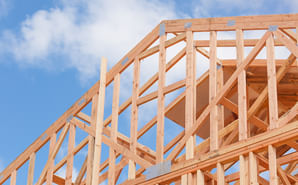Rebuilding Your Home DA Information
A checklist and guide to preparing your Development Application
Rebuilding Your Home - Checklist for New Dwellinigs
We are working with our community in the rebuilding efforts following the recent events. All rebuild applications will be fast tracked to help you get back into your homes.
This checklist is designed to help guide you through what you need to do to rebuild.
To achieve a streamlined, fast development process, we recommend you engage the services of a suitably qualified building consultant/designer to put your application together for you.
-
Step 1
Confirm you have a building entitlement. Read more...
-
Step 2
Arrange a free Council pre-DA site inspection to assist with bushfire, on-site sewage management (OSM) and biodiversity assessments. Read more...
-
Step 3
Design your new home. Read more...
-
Step 4
Lodge your Development Application (DA). Read more...
-
Step 5
Receive approval via a Development Consent and Construction Certificate before building. Read more...
-
Step 6
Rebuild to specifications. Read more...
-
Step 7
Receive your final occupation certificate. Read more...
We're here to help
If after reading the following information, you have any questions regarding the rebuild process, please contact the Council on (02) 6499 2222 or email council@begavalley.nsw.gov.au
Step 1 - How do I know if I can rebuild?
To confirm if your property does have a building entitlement you can email council@begavalley.nsw.gov.au. Please include your property address, Lot/s & DP if possible and we will research this for you. Once you have this information, you’ll need to put together a development application (DA).
Step 2 - Determine building constraints
Arrange free Council site inspection – to discuss Bushfire Attack Level (BAL), OSM & biodiversity assessment requirements. Call Council on (02) 64992222 or email council@begavalley.nsw.gov.au to arrange an inspection. Alternatively, you can complete the relevant application form below and email it to council@begavalley.nsw.gov.au
Step 3 - The exciting part - designing your new home
We would recommend you engage the services of a suitably qualified building consultant/designer/draftsperson to put together your house plans. Before you book in to meet with your consultant, there are a few things that you need to consider:
- Your new home layout and look
- If you are considering using the exact plans of your previous home, you can obtain a copy through Customer Service by submitting a Request to view Property File/DA File Form. Its completely free and will allow you to obtain copies of your previous home. You can take these to your consultant to get updated plans drawn to meet legislative building standards.
- The Bushfire Attack Level (BAL) rating
- Are you going to use a Licenced Builder or are you going to be an Owner Builder?
- Design to minimise clearing of native vegetation as far as possible as this will protect habitat for native species and require less biodiversity assessment.
For homes with young families or older occupants it is well worth considering a design that meets the Design guidelines (livablehousingaustralia.org.au)
Step 4 - Lodging your Development Application
Your Development Application (including modifications and reviews) and Construction Certificate application (if using Council as the Certifier) must be submitted to Council online via the NSW Planning Portal.
For more information, visit our Planning Portal information page.
The forms you need to lodge your Development Application
The Development Application should include:
- Statement of Environmental Effects
- Cost Summary Report
- An Occupational Hygienist’s Clearance Certificate (if your site had asbestos – provided by Public Works) Link to Certificate Form
- Your Site Plan
- Your House Plan which includes:
- Floor plan (with smoke alarms to be shown)
- Any wood burning heaters that are included
- Specifications
- Elevations
- Finished floor levels
- North point shown on the plans
- For rural and residential development, contour and level details that extend to the public road, not just to the boundary of the property.
- Engineering details if applying for a Construction Certificate
- A BASIX Certificate (Your new homes energy efficiency report)
- An Aboriginal Heritage Information Management Systems (AHIMS) report
- An Aboriginal Due Diligence Statement
- A Biodiversity Values Map & Threshold Tool (BMAT) report - If clearing native vegetation (including shrubs and groundcover) as part of the DA
-
A Bushfire Report BAL Assessment
Section 68 of the Local Government Act Applications:
- Application to Install, Construct or Alter and operate a system of On-site Sewage Management (OSM). If you would like to have your existing OSM system inspected to ensure a new dwelling can be connected into it, please advise us and we can arrange this inspection for you at no cost.
- Application to install a transportable dwelling (only if installing a relocatable/transportable dwelling)
Roads Act Application
- A Section 138 (only if any works are proposed over the Council road reserve. i.e. new driveways)
The forms you need to lodge your Construction Certificate (if using Council for the Certification):
Note: a Construction Certificate is not required for installation of a transportable dwelling.
- Performance of Certification Work Contract of Agreement (if you are using Council for the certification/inspections)
- Engineering specifications
- Home Building Compensation Fund (HBCF) insurance or Owner Building Permit.
What are the fees involved?
All Council application fees associated with the lodgement of a development application (including any pre-lodgement advice, a construction certificate and other certificates for current owners to rebuild their lost or damaged buildings or subsequent inspections) have been waived for rebuilds that are substantially the same as what was lost (however don’t need to have exactly the same footprint or be located in the same location as the previous dwelling if a better design and/or location on the lot is identified). If there will be any substantial difference (e.g. larger size), fees will be charged on the difference only.
However, Section 7.11/7.12 Contributions may still be required to be paid (unless the dwelling to be replaced was constructed prior to 1965). If you would like to know if any Contributions will be payable for the rebuild please email council@begavalley.nsw.gov.au with the word ‘Contributions’ in the subject line and the property address.
Step 5 - Your construction Certificate and Development Consent
Once your Development Application has been approved and Contributions are paid (if applicable), you will receive a Construction Certificate (if Council is your appointed Certifier).
A Construction Certificate confirms that the construction plans and development specifications are consistent with the development consent, and comply with the Building Code of Australia and any other Council requirements. A Construction Certificate can be issued by Council or a private certifier. Your Construction Certificate will contain all the information you need to know about the inspections required throughout the build process.
When you have your Construction Certificate and Development Consent, you can start by submitting:
- Your Notice of Commencement form; and
- Your Plumber will submit a Notice of Works form
You can now start building.
Step 6 - Rebuild to specifications
Your builder or contractors will need to build to the plans and specifications. The inspections as outlined in the Development Consent will need to be followed throughout the process.
Step 7 - Receive your Final Occupation Certificate
When the building is complete, arrange through Council, or your private certifier an occupation inspection. Provided the home is built to specifications, you will receive your Final Occupation Certificate and Part Final Occupation Certificate. You can then move into your brand new home.
Useful Information
Quick links
- How do I find out the Bushfire Attack Level (BAL) Rating?
- Biodiversity Assessment
- Licenced Building verses Owner Builder
- My property has been identified as containing asbestos
- What is an Aboriginal Due Diligence Statement?
- What is a BASIX Certificate?
- What is an Aboriginal Heritage Information Management System Report and how do I get one?
- What is an Aboriginal Due Diligence Statement?
- Due Diligence Assessment - Application requirements
How do I find out the Bushfire Attack Level (BAL) Rating?
Your level of bushfire risk affects your development requirements – the higher the risk, the more protection you need. We use the term ‘bushfire attack level’, or BAL, to quantify this risk. Your level of bushfire risk is affected by the area you live, the vegetation, the distance from the vegetation to your home, and the slope. As part of your rebuild process, you will need to confirm your BAL in a written report.
Council can arrange for one of our staff to visit your property and determine your BAL rating for you. This will be only up to BAL 40 (not flame zone). If you would like this service provided, please email council@begavalley.nsw.gov.au and in the subject line include the words BAL assessment, your property address and your Lot Number and DP.
You can also find out your bushfire category going to NSW Planning Portal website www.planningportal.nsw.gov.au
- Click on Find a Property
- Enter property address or Lot & DP
- On the left hand side of the screen under Hazard – click the down arrow and click in the box next to Bushfire Prone Land
- On the right hand side of the screen click the + symbol next to Bushfire Prone Land
- This will then show the bushfire category/categories relevant to your property.
- For category 1, 2 or 3 vegetation/grasslands or vegetation buffer you will need to complete Section Two Bushfire Assessment on pages 19-24 of Building in bushfire prone areas Single Dwelling Application kit to determine your BAL rating.
This document can be found at: www.rfs.nsw.gov.au/__data/assets/pdf_file/0017/4355/Guidelines-for-Single-Dwelling-Development-Applications.pdf
If you need to engage the services of a Bushfire Planning and Design Consultant (BPAD), a list of accredited assessors can be found at www.fpaa.com.au
Please contact Council on (02) 6499 2222 should you need any further assistance.
Biodiversity Assessment
Biodiversity legislation can be complex and Council is committed to helping post fire rebuilds through the biodiversity assessment process as smoothly as possible. Contact Council as early as possible in the planning phase to discuss any biodiversity assessments/reports that may be required.
For rebuilds with minimal biodiversity impacts, e.g. rebuilding on the existing site with minimal requirement for native vegetation clearing, council will undertake any assessments on behalf of the applicant. Should more extensive clearing be required, e.g. rebuilding on a new site or extensive clearing for Asset Protection Zones or new access, council will advise the applicant on the biodiversity assessment requirements and who will be responsible for undertaking that assessment.
Implications of the following pieces of legislation will be considered in any post fire rebuild DA Assessment:
The Biodiversity Offset Scheme threshold (BOS) Threshold is a test used to determine when is necessary to engage an accredited assessor to apply the Biodiversity Assessment Method (the BAM) to assess the impacts of a proposal.
The thresholds for entry into the BOS are any of the following:
- Development is located on the Biodiversity Values Map
- Area clearing threshold is exceeded (refer to Table 1 below)
- Impacts to threatened species/communities (determined through a test of significance)
If clearing and other impacts exceeds the trigger thresholds, the BOS applies to the proposed development and a Biodiversity Development Assessment Report (BDAR) must be prepared and submitted with their application.
| Minimum lot size associated whe property | Threshold for clearing, above which the BAM and offsets scheme apply |
|---|---|
| Less than 1 ha | 0.25 ha or more |
| 1 ha tless than 40 ha | 0.5 ha or more |
| 40 ha to less than 1000 ha | 1 ha or more |
| 1000 ha or more | 2 ha or more |
Table 1 Biodiversity Offsets Scheme clearing area thresholds (Council can confirm which minimum Lot size applies)
Applicants are advised to check their proposal against the first two thresholds above by accessing the Biodiversity Values Map and Threshold (BMAT) tool at: www.lmbc.nsw.gov.au/Maps/index.html?viewer=BOSETMap
A BMAT user guide can be found at: The Biodiversity Values Map and threshold tool | NSW Environment and Heritage
Council staff will assess the third threshold, impacts to threatened species, through a site visit. Should impacts to threatened species be likely further assessment by the applicant may be required.
Further information on the BOS can be found at the link below: www.environment.nsw.gov.au/topics/animals-and-plants/biodiversity/biodiversity-offsets-scheme/how-it-works
Commonwealth Environmental Protection and Biodiversity Conservation Act (EPBC Act)
The EPBC Act is the Australian Governments key piece of environmental legislation, focussing on the protection of matters of national environmental significance including species and ecosystems.
Potential impacts to matters of environmental significance need to be assessed as part of a Development Application and council staff will assist applicants through this process.
Further information on the EPBC Act and associated environmental assessment can be found at https://www.environment.gov.au/epbc/environment-assessment-and-approvals
Licenced Building verses Owner Builder
Registered builders are insured tradesmen who manage the build including the contracting of licenced tradespeople. They are responsible for managing permits and organising inspections on your behalf.
As an owner builder, you take on many of the responsibilities of a registered builder and accept any associated financial risks. Responsibilities include:
- doing all or part of the work yourself, except work that must be carried out by licensed tradespeople
- contracting out all or part of the work to tradespeople, and checking they are registered and licensed if required
- choosing whether to engage a building consultant to independently advise you during the construction period. A building consultant can check the quality of your work and the work of those you engage
- arranging insurance
- occupational health and safety of workers
- obtaining permits and organising inspections
Advantages may include:
- more control over the project, including design
- saving the cost of the builder’s margin
- more flexibility
Risks include:
- spending more money and time than expected
- taking responsibility for the work and finance
- facing complex situations
My property has been identified as containing asbestos
Is there any additional paperwork I need before I can start my re-build?
Once the site has been cleaned by either the NSW Government’s appointed contractor or your self-appointed contractor, you will need to ask for the Occupational Hygienist’s Clearance Certificate. Council (or your Private Certifier) will need to sight a copy of that Certificate prior to the issue of a Construction Certificate.
What does my site plan need to include?
Your A3 site plan should include:
- First & secondary land application areas if having new absorption trenches for an onsite sewage management system
- Site levels
- Storm water drainage
- All distances to boundaries and between proposed developments on your site.
- The Asset Protection Zone (APZ) area. The APZ dimensions need to demonstrate the boundaries of the property plus the distance and slope (in degrees) to the bushfire threat (hazard)
- The site plan will need to clearly label any trees that are there and any marked for removal. We will require photos of any trees that you may propose for removal as part of this build.
- If you are removing any native vegetation (including ground cover e.g. native grasses) you will need to complete the attached Biodiversity Values Map & Threshold Tool (BMAT) report- see link below to ensure the amount of clearing you are proposing to do is under the threshold.www.lmbc.nsw.gov.au/Maps/index.html?viewer=BOSETMap
- The site plan will need to show the calculations for clearing with all these areas considered: House footprint, earthworks, Asset Protection Zone, driveway, access road & site work.
- If you are not clearing any native vegetation, we will need a statement from you to confirm this and a site photo to support your claim.
What is a BASIX Certificate?
The Building Sustainability Index (BASIX) requirements apply to all residential dwelling types and are part of the development application process in NSW. In NSW, there are BASIX requirements for water and energy usage and thermal comfort performance that apply to:
- all new residential dwellings
- alterations and additions to dwellings that cost $50,000 or more
- swimming pools of 40,000 litres or more
To obtain your BASIX Certificate, call the Department of Planning dedicated BASIX bushfire recovery hotline 1300 054 464 or visit www.planningportal.nsw.gov.au/planning-tools/basix
- All BASIX commitments need to be clearly shown on plans and specifications.
- The certificate is only valid for three months.
What is an Aboriginal Heritage Information Management System Report and how do I get one?
The Aboriginal Heritage Information Management System (AHIMS) is a database that contains detailed information on recorded sites of Aboriginal and Cultural Heritage. It is used to help identify, manage, conserve and protect local sites and heritage. In line with the current legislation, we require an Aboriginal Heritage Information Management Systems (AHIMS) report (this is a 2 page document) as part of your Development Application. Please ensure you set the search parameter to 200m.
Reports can be obtained from: www.environment.nsw.gov.au/awssapp/Login.aspx?ReturnUrl=%2fawssapp%2fMySearches.aspx.
If you are having issues obtaining this report on your property, contact ahims@environment.nsw.gov.au.
What is an Aboriginal Due Diligence Statement?
In accordance to legislative requirements, the Aboriginal Due Diligence Statement demonstrates that you have considered:
- any potential impacts on items of Aboriginal Heritage; plus
- the potential likelihood of Aboriginal artefacts being contained within the site to be disturbed; and
- that should any objects or places be found within the site, works will stop immediately and the relevant authorities will be contacted.
Due Diligence Assessment - Application requirements:
Where a development will disturb the ground surface and/or may impact on Aboriginal cultural or spiritual values, the development application must demonstrate that a Due Diligence assessment has been undertaken by the applicant or a suitably qualified person. This includes (but is not limited to) submitting the following documentation in accordance with the Due Diligence Code of Practice for the Protection of Aboriginal Objects in NSW:
- A statement and results of a basic 200m AHIMS search. Where a site is identified within 200m of the development site the results of an extensive AHIMS search are required.
- A statement identifying whether the development site is partially or wholly within the area identified as having ahigh probability of Aboriginal cultural heritage values on the Aboriginal Cultural Heritage Landscape Map(see Figure 5.1b).
- A statement indicating whether there are landscape features that indicate the potential presence of Aboriginal objects. Landscape features include foreshore areas, creek lines, rocky areas, wetlands, ridge tops, ridgelines, headlands, sand dunes and caves. Figure 5.1a illustrates several landscape features where there is potential for Aboriginal sites to occur.
- A statement indicating if previous Aboriginal Cultural Heritage studies have been undertaken on the subject land Note: if any previous Aboriginal Cultural Heritage studies demonstrate that adequate Due Diligence was undertaken at that time, those reports can be taken into consideration. Council staff may be able to assist you in locating any previous reports.
- A statement indicating if the development site is a within a declared Aboriginal Place of Significance as listed in Schedule 5 of the Bega Valley Local Environmental Plan 2013.
For more information refer to Section 5.1 Aboriginal Heritage in Bega Valley Development Control Plan (BVDCP) 2013.







